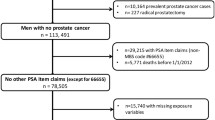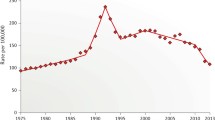Abstract
Objectives
To investigate the impact of different PSA testing policies and health-care systems on prostate cancer incidence and mortality in two countries with similar populations, the Republic of Ireland (RoI) and Northern Ireland (NI).
Methods
Population-level data on PSA tests, prostate biopsies and prostate cancer cases 1993–2005 and prostate cancer deaths 1979–2006 were compiled. Annual percentage change (APC) was estimated by joinpoint regression.
Results
Prostate cancer rates were similar in both areas in 1994 but increased rapidly in RoI compared to NI. The PSA testing rate increased sharply in RoI (APC = +23.3%), and to a lesser degree in NI (APC = +9.7%) to reach 412 and 177 tests per 1,000 men in 2004, respectively. Prostatic biopsy rates rose in both countries, but were twofold higher in RoI. Cancer incidence rates rose significantly, mirroring biopsy trends, in both countries reaching 440 per 100,000 men in RoI in 2004 compared to 294 in NI. Median age at diagnosis was lower in RoI (71 years) compared to NI (73 years) (p < 0.01) and decreased significantly over time in both countries. Mortality rates declined from 1995 in both countries (APC = −1.5% in RoI, −1.3% in NI) at a time when PSA testing was not widespread.
Conclusions
Prostatic biopsy rates, rather than PSA testing per se, were the main driver of prostate cancer incidence. Because mortality decreases started before screening became widespread in RoI, and mortality remained low in NI, PSA testing is unlikely to be the explanation for declining mortality.





Similar content being viewed by others
Abbreviations
- APC:
-
Annual percentage change
- ASR:
-
Age-standardized rate
- NCRI:
-
National Cancer Registry Ireland
- NI:
-
Northern Ireland
- NICR:
-
Northern Ireland Cancer Registry
- PSA:
-
Prostate-specific antigen
- RoI:
-
Republic of Ireland
References
Kvåle R, Auvinen A, Adami HO, Klint Å, Hernes E, Møller B et al (2007) Interpreting trends in prostate cancer incidence and mortality in the five Nordic countries. J Natl Cancer Inst 99(24):1881–1887
Hussain S, Gunnell D, Donovan J, McPhail S, Hamdy F, Neal D et al (2008) Secular trends in prostate cancer mortality, incidence and treatment: England and Wales, 1975–2004. BJU Int 101(5):547–555
Oliver SE, May MT, Gunnell D (2001) International trends in prostate-cancer mortality in the “PSA ERA”. Int J Cancer 92(6):893–898
Bouchardy C, Fioretta G, Rapiti E, Verkooijen HM, Rapin CH, Schmidlin F et al (2008) Recent trends in prostate cancer mortality show a continuous decrease in several countries. Int J Cancer 123(2):421–429
Oberaigner W, Horninger W, Klocker H, Schönitzer D, Stühlinger W, Bartsch G (2006) Reduction of prostate cancer mortality in Tyrol, Austria, after introduction of prostate-specific antigen testing. Am J Epidemiol 164(4):376–384
Hankey BF, Feuer EJ, Clegg LX, Hayes RB, Legler JM, Prorok PC et al (1999) Cancer surveillance series: interpreting trends in prostate cancer—part 1: evidence of the effects of screening in recent prostate cancer incidence, mortality, and survival rates. J Natl Cancer Inst 91(12):1017–1024
Feuer EJ, Merrill RM, Hankey BF (1999) Cancer surveillance series: interpreting trends in prostate cancer—part II: cause of death misclassification and the recent rise and fall in prostate cancer mortality. J Natl Cancer Inst 91(12):1025–1032
Etzioni R, Legler JM, Feuer EJ, Merrill RM, Cronin KA, Hankey BF (1999) Cancer surveillance series: interpreting trends in prostate cancer—part III: quantifying the link between population prostate-specific antigen testing and recent declines in prostate cancer mortality. J Natl Cancer Inst 91(12):1033–1039
Andriole GL, Grub RL III, Buys SS, Chia D, Church TR, Fouad MN et al (2009) Mortality results from a randomized prostate-cancer screening trial. N Engl J Med 360(13):1310–1319
Schröder FH, Hugosson J, Roobol MJ, Tammela TL, Ciatto S, Nelen V et al (2009) Screening and prostate-cancer mortality in a randomized European study. N Engl J Med 360(13):1320–1328
Shaw PA, Etzioni R, Zeliadt SB, Mariotto A, Karnofski K, Penson DF et al (2004) An ecologic study of prostate-specific antigen screening and prostate cancer mortality in nine geographic areas of the United States. Am J Epidemiol 160(11):1059–1069
Collin SM, Martin RM, Metcalfe C, Gunnell D, Albertsen PC, Neal D et al (2008) Prostate-cancer mortality in the USA and UK in 1975–2004: an ecological study. Lancet Oncol 9(5):445–452
Ferlay J, Autier P, Boniol M, Heanue M, Colombet M, Boyle P (2007) Estimates of the cancer incidence and mortality in Europe in 2006. Ann Oncol 18(3):581–592
Drummond FJ, Sharp L, Comber H (2008) Major inter-laboratory variations in PSA testing practices: results from national surveys in Ireland in 2006 and 2007. Ir J Med Sci
NHS Cancer Screening Programmes. Prostate Cancer Risk Management. Available at http://www.cancerscreening.nhs.uk/prostate/index.html
Gavin A, McCarron P, Middleton RJ, Savage G, Catney D, O’Reilly D et al (2004) Evidence of prostate cancer screening in a UK region. BJU Int 93(6):730–734
Mostofi FK (1975) Grading of prostatic carcinoma. Cancer Chemother Rep 59(1):111–117
Drummond FJ, Carsin AE, Sharp L, Comber H (2010) Trends in prostate specific antigen testing in Ireland: lessons from a country without guidelines. Ir J Med Sci 179(1):43–49
Connolly D, Black A, Gavin A, Keane PF, Murray LJ (2008) Baseline prostate-specific antigen level and risk of prostate cancer and prostate-specific mortality: diagnosis is dependent on the intensity of investigation. Cancer Epidemiol Biomarkers Prev 17(2):271–278
Anderson RN, Minino AM, Hoyert DL, Rosenberg HM (2001) Comparability of cause of death between ICD-9 and ICD-10: preliminary estimates. Natl Vital Stat Rep 49(2):1–32
Central Statistic Office Ireland. Available at http://www.cso.i.e
Kim HJ, Fay MP, Feuer EJ, Midthune DN (2000) Permutation tests for joinpoint regression with applications to cancer rates. Stat Med 19(3):335–351
Joinpoint regression program (version 3). National Cancer Institute. Available at http://srab.cancer.gov/joinpoint/
Draisma G, Boer R, Otto SJ, van der Cruijsen IW, Damhuis RA, Schröder FH et al (2003) Lead times and overdetection due to prostate-specific antigen screening: estimates from the European Randomized Study of Screening for Prostate Cancer. J Natl Cancer Inst 95(12):868–878
Telesca D, Etzioni R, Gulati R (2008) Estimating lead time and overdiagnosis associated with PSA screening from prostate cancer incidence trends. Biometrics 64(1):10–19
Bill-Axelson A, Holmberg L, Ruutu M, Haggman M, Andersson SO, Bratell S et al (2005) Radical prostatectomy versus watchful waiting in early prostate cancer. N Engl J Med 352:1977–1984
Drummond FJ, Carsin AE, Sharp L, Deady S, Cronin-Fenton DP, Comber H (2007) Treatment of prostate cancer in the real world: population-based practices, factors associated with treatment receipt and impact on survival. J Epidemiol Commun Health 61(Suppl I):A21
Gavin A, Hughes J, Ranaghan L, Fitzpatrick D. Cancer services audit 1996 & 2001, prostate. N. Ireland Cancer Registry; 2005
Kumar S, Shelley M, Harrison C, Coles B, Wilt TJ, Mason MD (2006) Neo-adjuvant and adjuvant hormone therapy for localised and locally advanced prostate cancer. Cochrane Database Syst Rev 18:CD006019
Antonarakis ES, Blackford AL, Garrett-Mayer E, Eisenberger MA (2007) Survival in men with non metastatic prostate cancer treated with hormone therapy: a quantitative systematic review. J Clin Oncol 25:4998–5008
NicAmhlaoibh R, Mahmud S, Comber H (2004) Patterns of care and survival from cancer in Ireland 1994 to 1998. National Cancer Registry, Cork
Demers RY, Tiwari A, Wei J, Weiss LK, Severson RK, Montie J (2001) Trends in the utilization of androgen-deprivation therapy for patients with prostate carcinoma suggest an effect on mortality. Cancer 92(9):2309–2317
Damber JE (2004) Decreasing mortality rates for prostate cancer: possible role of hormonal therapy? BJU Int 93(6):695–701
Seidenfeld J, Samson DJ, Hasselblad V, Aronson N, Albertsen PC, Bennett CL et al (2000) Single-therapy androgen suppression in men with advanced prostate cancer: a systematic review and meta-analysis. Ann Intern Med 132(7):566–577
Docherty A, Brothwell CP, Symons M (2007) The impact of inadequate knowledge on patient and spouse experience of prostate cancer. Cancer Nurs 30(1):58–63
Gormley GJ, Catney D, McCall JR, Reilly PM, Gavin AT (2006) Prostate-specific antigen testing: uncovering primary care influences. BJU Int 98(5):996–1000
Drummond FJ, Carsin A-E, Sharp L, Comber H (2009) Factors prompting PSA-testing of asymptomatic men in a country with no guidelines: a national survey of general practitioners. BMC Fam Pract 10:3
Connolly D (2007) Long term follow-up of men with elevated prostate specific antigen levels: a population based study. MD thesis, Queen’s University Belfast, Belfast
Legler JM, Feuer EJ, Potosky AL, Merrill RM, Kramer BS (1998) The role of prostate-specific antigen (PSA) testing patterns in the recent prostate cancer incidence decline in the United States. Cancer Causes Control 9(5):519–527
Brewster DH, Fraser LA, Harris V, Black RJ (2000) Rising incidence of prostate cancer in Scotland: increased risk or increased detection? BJU Int 85(4):463–473
Eichler K, Wilby J, Hempel S, Myers L, Kleijnen J (2005) Diagnostic value of systematic prostate biopsy methods in the investigation for prostate cancer: a systematic review. Centre for Reviews and Dissemination, York, July 2005. Report No: 29
Cooperberg MR, Broering JM, Kantoff PW, Carroll PR (2007) Contemporary trends in low risk prostate cancer: risk assessment and treatment. J Urol 178:S14–S19
Health in the European Union. September 2007. Report No.: Special Eurobarometer 272
Acknowledgments
We are grateful to the staff of the Northern Ireland Cancer Registry and the National Cancer Registry Ireland who collected and processed the cancer registration data used in this paper. In particular, we thank Mr Colin Fox, Ms Wendy Hamill and Mr Richard Middleton for their help in providing the data from NI and Christine Buicke for reviewing death certificates in the RoI. We are also grateful to colleagues at HIPE, VHI Healthcare and BUPA for providing biopsy data, and staff in hospitals and laboratories for providing PSA data.
Competing interest statement
All authors declare that the answer to the questions on your competing interest form are all no and therefore have nothing to declare.
Details of contributors
AEC did the statistical analyses. FD collected and provided data on biopsies and PSA tests in the RoI. AB provided the data on PSA tests in NI. PL helped with prostate cancer grade and stage data collection in NI. DC provided the biopsy data in NI. FD, AB, LS, LM, PA, MB, HC and AG took part in the study design. AEC, FD, LS, PA, LE, HC, AG wrote and revised the article. All authors were involved in revisions and approved the final version. AEC is the guarantor for the study.
Funding
The Northern Ireland Cancer Registry is funded by the Public Health Agency Northern Ireland, and the National Cancer Registry of Ireland is funded by the Department of Health and Children (Republic of Ireland). Some aspects of the data collection for this study were funded by a grant from the Northern Ireland Research & Development Office and the Health Research Board (Dublin) [grant number NS/2004/20]. The study funders had no role in the study design, the collection, analysis and interpretation of the data. All authors were independent from the funding source.
Author information
Authors and Affiliations
Corresponding author
Rights and permissions
About this article
Cite this article
Carsin, AE., Drummond, F.J., Black, A. et al. Impact of PSA testing and prostatic biopsy on cancer incidence and mortality: comparative study between the Republic of Ireland and Northern Ireland. Cancer Causes Control 21, 1523–1531 (2010). https://doi.org/10.1007/s10552-010-9581-y
Received:
Accepted:
Published:
Issue Date:
DOI: https://doi.org/10.1007/s10552-010-9581-y




